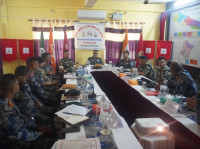Madhesh Province
Wildlife from Chure forests entering human settlements in search of water
Animals like wild boars and blue bulls reach settlements that border with India, terrorising the locals..jpg&w=900&height=601)
Laxmi Sah
Krishna Devi Yadav of Kachorwa sustained severe injuries when a wild boar attacked her on January 16. The 45-year-old had to be taken to National Medical College in Birgunj for treatment.
“A wild boar from the Chure forests had entered the settlement. Krishna was collecting fodder in the nearby field when the boar attacked her,” said Bachchha Yadav, Krishna’s uncle. According to him, wild animals frequently enter settlements and destroy crops.
Kachorwa, which lies near the Nepal-India border in Simraungadh Municipality Ward No. 8 of Bara, is around 40km south of the Chure forests. Locals say wildlife, including wild boars, blue bulls, deer and monkeys, has started entering settlements and wreaking havoc of late.
“Wild animals destroy crops planted in hectares of land. Big animals generally do not venture into the settlements; it’s the smaller ones like wild boars and blue bulls that terrorise us. The forest office and the national park are indifferent towards our problems,” said Pannalal Das, a farmer of Piprabirta in Mahagadhimai Municipality.
According to conservationists, wild animals have started moving south to the settlements that border India, as water sources in the Chure forest region are drying up. Rampant deforestation and haphazard extraction of sand and pebbles in the Chure range in the past few years have led to a depletion of water sources.
“Water level in various rivers and rivulets have gradually started decreasing due to rampant deforestation and exploitation of riverbed materials. Chure forests, until a few years back, had several sources of water, but most have dried up now. Wild animals are moving south in search of water,” said Rabindra Singh, chairman of Halkhoriya Collaborative Forest Management Committee.
Amir Maharjan, chief of Parsa National Park, admits that a shortage of water sources is forcing wild animals to move south towards the no-man’s-land.
“The population of wild animals is also on the rise, which is good news, but we must manage proper habitat to accommodate the growing number,” said Maharjan. According to him, the number of animals like deer, tiger, leopard, wild boar, monkey and the blue bull has increased significantly in the past few years.
There were four tigers in the area during the tiger census held in 2010. The latest census conducted in 2018 showed 18 tigers in the park forests. It is estimated that there are around 60 to 65 elephants and four to six rhinos in the area. The government in 2017 declared Parsa Wildlife Reserve as Parsa National Park. The park occupies 627 square kilometre area, including the forests of Parsa, Bara and Makwanpur.
Conservationists have stressed on the need to preserve water sources in the Chure region in order to conserve the wildlife and prevent them from entering human settlements.
“The authorities concerned should immediately make plans and policies to address this issue. Big animals like elephant, rhino and tiger will also start entering human settlements if the problem is not addressed at the earliest,” said Baburam Gopali, a former warden of the park.




 11.12°C Kathmandu
11.12°C Kathmandu












